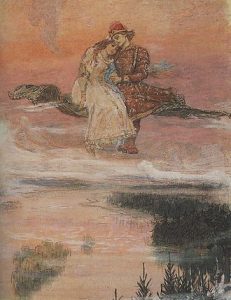Though virus restrictions continue to immobilise us, or at least rule out international touring, we can still visit far-off lands quite easily. Yesterday, in perfect comfort and without risking infection or breaching flight prohibitions or incurring any expense, I spent a few pleasant hours in a foreign country. How? Magical travel.
One of the Arabian Nights tales tells how a prince acquires a carpet with wonderful properties:
“Whoever sitteth on this carpet and willeth in thought to be taken up and set down upon another site will, in the twinkling of an eye, be borne thither, be that place near-hand or distant many a day’s journey and difficult to reach.”
This princely device is within our own reach. We all have access to imagination’s magic carpet whenever we pick up a book.
Almost any act of reading takes us metaphorically from one place to another, even if the content of what we read may not involve a sequence of actions and locations. Traversing the text brings us to a mental destination that’s different from where we began. But this imaginary journey structure is most salient when we engage with narrative forms — not only novels or short stories but also non-fictional travel literature.
Travel literature has a long history, going back to writers such as Pausanias, a peripatetic Greek cultural geographer in the 2nd century AD. The genre came into its own in the Victorian period, when steamship and rail opened up the world to large numbers of tourists whose appetite for exotic journeys was stimulated by itinerant journalists. (The restless main characters in my novel The End of Longing, set in the late 19th-century, embody this new-found transnational mobility.)
But then the first half of the 20th century, with its devastating experiences of two world wars, economic depression, fearsome pandemics and widespread poverty, pushed leisure travel out of the reach of many people. So by the 1950s the reading of travel literature had become a popular substitute for journeying in person.
 Which brings me back to my imaginary excursion yesterday: it was achieved through H.V. Morton’s A Stranger in Spain (1955). This book has been on my shelf for many years (I acquired it as a school prize), and reading it took me not only to the particular country that is its subject but also back to the time when it was written. In my corner of the world, that was a period before TV documentaries brought remote locations into the home, and before most people had the wherewithal to afford any bodily expeditions to Europe.
Which brings me back to my imaginary excursion yesterday: it was achieved through H.V. Morton’s A Stranger in Spain (1955). This book has been on my shelf for many years (I acquired it as a school prize), and reading it took me not only to the particular country that is its subject but also back to the time when it was written. In my corner of the world, that was a period before TV documentaries brought remote locations into the home, and before most people had the wherewithal to afford any bodily expeditions to Europe.
So travelogue books like Morton’s were a primary source of information about unfamiliar places. In those days of cheap publication they seldom carried high-quality photographs, if any. The writer had to bring places and people and culture to life through resourceful uses of language. This was “creative non-fiction” before the term was invented.
In A Stranger in Spain the creative element isn’t a matter of elaborately depicted scenery and splashes of local colour. What Morton often does, with skilful economy, is to focus on particular individuals and their activities in a way that evokes a characteristic cultural attitude.
I was impressed by the white cotton gloves which the Customs officers drew on before they probed into the luggage. I was soon to learn that white gloves are a symbol of the Spanish sense of fitness. A glove is an aristocratic symbol, and was once worn only by kings and bishops. As the world becomes more democratic one sees fewer gloves, and the clenched fist, of course, is always bare.

